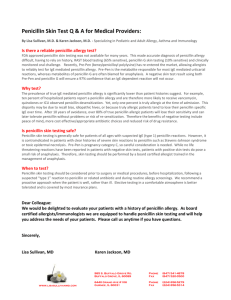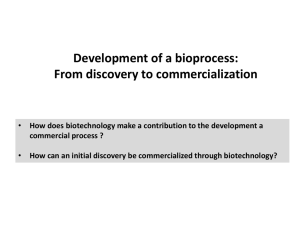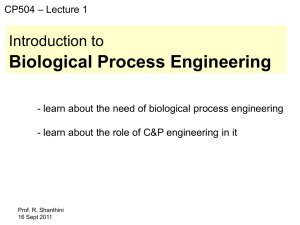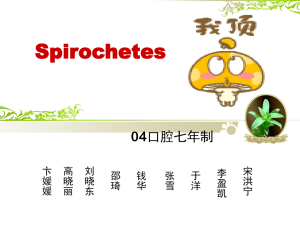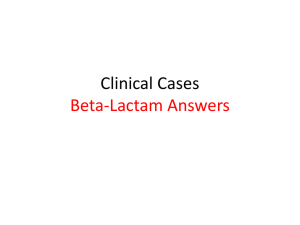PeniciRepGr1 98
advertisement
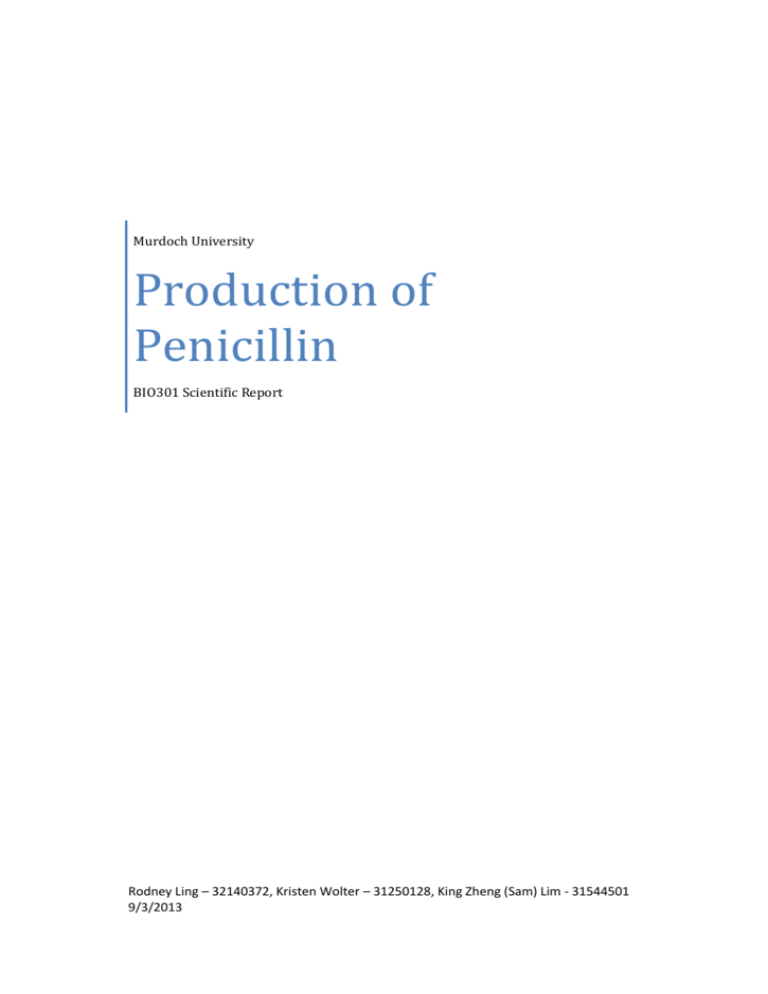
Murdoch University Production of Penicillin BIO301 Scientific Report Rodney Ling – 32140372, Kristen Wolter – 31250128, King Zheng (Sam) Lim - 31544501 9/3/2013 Introduction Some microorganisms are able to form various types of metabolites. These are characterised into primary and secondary metabolites. Primary metabolites are those which are utilised for growth, development and reproduction, while secondary metabolites are not required for growth and are generally produced towards the end of the stationary phase of growth. Microorganisms which produce secondary metabolites display two phases in batch culture known as trophophase and idiophase (Waites et al, 2009). Nice and clear and referenced. Trophophase is defined as the growth phase of the culture, while idiophase is the period following this when the secondary metabolites are produced (Waites et al, 2009). During idiophase, primary metabolites are utilised to produce species-specific products that are not essential for growth, known as secondary metabolites (Waites et al, 2009). Examples of microorganisms that produce secondary metabolites are those from the Penicillium genus. Penicillium chrysogenum is one such microorganism which produces a secondary metabolite known as penicillin G or benzylpenicillin. Source? Utilization of the side-chain precursors phenoxyacetic acid (POA) and phenylacetic acid (PA) for penicillin biosynthesis by Penicillium chrysogenum was studied in shake flasks. By whom? Precursor uptake and penicillin production were followed by HPLC analysis of precursors and products in the medium and in the cells. By whom? P. chrysogenum used both POA and PA as precursors, producing phenoxymethylpenicillin (penicillin V) and benzylpenicillin (penicillin G), respectively. Specify the objective at the end of introduction Methods Preparation of Inoculum: 5ml of Penicillium growth medium was added to an agar slope culture of P.chrysogenum. After swirling to suspend the spores, the suspension was added to 500ml conical flasks containing 100ml of growth medium. Flasks were incubated at 25oC and placed in the refrigerator while growth was still exponential. Inoculation: 7 500ml conical flasks (labelled day 0-7) containing 100ml of penicillin production medium were inoculated with 3ml of P.chrysogenum pre-culture (approximately 3 penicillin balls per 3ml). Sampling: Immediately following inoculation a 1ml sample was taken from the day 0 flask and stored in the freezer. The other flasks were placed on a shaking platform at 25oC for incubation. The following day, the day 1 flask was removed and a 1ml sample taken and frozen. This was performed for all 7 flasks resulting in samples taken in daily intervals. Determination of Antibiotic Production: To determine the amount of penicillin produced, 3 agar plates containing 2ml of Bacillus subtilis spore suspension and 50ml of nutrient agar were prepared. Plate A was used for standards (0.02-6 U/30µl), Plate B for undiluted samples (days 0-7) and Plate C for 1/10 diluted samples (days 0-7). 10 sterile discs were placed onto each plate with 30µl samples pipetted onto them. Plates were then incubated overnight at 37oC. The following day zones of clearing were measured were measured and compared to the standards to determine the antibiotic concentration of each day’s sample. Determination of Biomass: The biomass weight of each flask was also determined. Biomass was sieved off using strainers and transferred to foil dishes. These dishes were then placed in an 80oC oven overnight for drying. The following morning the weight of each day’s biomass was measured and recorded. Results The concentration of standard control penicillin in stock solution and the inhibition zone for each concentration on Plate A after 1 day of incubation are tabulated and it can be shown as Table 1. Table 1. Raw data of the diameter of inhibition zone according to each standard penicillin concentration control. A plot would be better than a table Standard control Diffusion diameter (units/30μL) (mm) 0 0 0.02 0 0.04 2 0.1 4 0.25 5 0.5 6 1 8 2 9 3 9 4 10 6 11 A diameter of 2 mm seems small considering that the disk is already larger than that. According to the data from Table 1, two standard curves of linear axis of penicillin concentration and a semi-log graph paper of penicillin concentration against the diameter of clearing zone were plotted in Figure 1 and Figure 2 respectively. The relationship between the concentration of standard control penicillin between the diameter of clearing zone was determined by using the build-in function called ‘trend line’ on excel and it is showed on Figure 1, which y represents the penicillin concentration and x represents the diameter of the inhibition zone, or simply 𝑃𝑒𝑛𝑖𝑐𝑖𝑙𝑙𝑖𝑛 𝑐𝑜𝑛𝑐. = 0.0156𝑒 0.5467∗𝑑𝑖𝑓𝑓𝑢𝑠𝑖𝑜𝑛 𝑑𝑖𝑎𝑚𝑒𝑡𝑒𝑟 . Wow, the correlation is impressive. This is beyond of what I expected from a short report. Penicillin conc. (units/30μL) Diffusion diameter 7 y = 0.0156e0.5476x R² = 0.9888 6 5 4 Diffusion diameter 3 2 Expon. (Diffusion diameter) 1 0 0 5 10 15 Diameter (mm) Figure 1 According to Figure 1, it is clear that there was an exponential relationship between the penicillin concentration and the diffusion diameter. Besides, according to the 𝑅 2 value indicated on Figure 1, the equation obtained by using the exponential trend line was relatively good provided that the 𝑅 2 value was higher than 80%, which indicated that the residual of the plot with respect to the line of best fit was relatively low. Thus the equation was reliable. Diffusion diameter Penicillin conc. (units/30μL) (semi-log axis) 10 3 2 1 4 6 y = 0.0156e0.5476x R² = 0.9888 1 0 5 0.1 0.5 0.25 10 15 Diffusion diameter Expon. (Diffusion diameter) 0.1 0.04 0.02 0.01 Diameter (mm) Figure 2 Since the relationship between the penicillin concentration and the inhibition zone was exponential, the plot of penicillin concentration on semi-log graph should generate a straight line, as shown as Figure 2. Also nice. I have not seen this plot before. For Plate B, the biomass dry weight and its diffusion diameter for each corresponding penicillin concentration from student samples are tabulated as Table 2. By using the relationship which was derived from Figure 1, the penicillin concentration from student sample can be calculated. Furthermore, given that the growth medium for the penicillin in each sample was 500mL, the concentration of biomass can be calculated and the results are tabulated in Table 2. Table 2: Biomass concentration, penicillin concentration and its diffusion diameter at each sampling times. Sample time (hr) 0 18 42 49 66 73 90 Student sample (units/30μL) 0 1 2 3 4 5 6 (Standard) 0.25 (Standard) 3 Diffusion diameter (mm) 2 2 2 5 8 9 10 5 10 Biomass (g) 0.0007 0.0164 0.0713 0.2098 1.1882 1.1131 2.1090 Biomass conc. (g/L) 0.0014 0.0328 0.1426 0.4196 2.3764 2.2262 4.2180 Penicillin conc. (units/30μL) 0.04664 0.04664 0.04664 0.24111 1.24647 2.15527 3.72667 Penicillin conc. (units/L) 1554.686 1554.686 1554.686 8037.142 41549.003 71842.307 124222.403 Penicillin Production Rate (PPR) (units/L/hr) 0 86.37143897 37.01633099 164.0233037 629.5303527 984.1411879 1380.248924 Plot of biomass and penicillin concentrations versus time on linear and semi-log graph is generated and it is as shown as Figure 3 and Figure 4 respectively. Biomass/ Penicillin conc. Biomass/ Penicillin conc. 4.0000 3.5000 3.0000 2.5000 2.0000 1.5000 1.0000 0.5000 0.0000 Biomass Penicillin conc. 0 20 40 60 80 100 time (hr) Figure 3 From Figure units are missing on the Y axis3, it is observed that the concentration of biomass and penicillin had increased after 40 hours of incubation. However, the amount of biomass produced was relatively low compared to the amount of penicillin produced after 60 to 70 hours and it was noticed that the concentration of penicillin at 90 hours was higher than that of the biomass. Biomass/ Penicillin conc. Biomass/ Penicillin conc. (semi-log axis) 10.0000 1.0000 0 20 40 60 80 100 0.1000 Biomass 0.0100 Penicillin conc. 0.0010 0.0001 time (hr) Figure 4 On the other hand, from the semi-log graph on Figure 4, the concentration of penicillin during the first 40 hours appeared to be static, in other words, did not increase in amount during that period. However, biomass concentration showed a fairly linear relationship with respect to time, which might suggesting it that the biomass of the culture increased exponentially. Additionally, it also showed that the biomass and penicillin production started to increase with the same rate at time 40 hours. From Table 2, the specific growth rate of the penicillin can be determined using the expression below: 𝑙𝑛𝑋𝑓𝑖𝑛𝑎𝑙 − 𝑙𝑛𝑋𝑖𝑛𝑖𝑡𝑖𝑎𝑙 𝜇= 𝑡𝑖𝑚𝑒 𝑖𝑛𝑡𝑒𝑟𝑣𝑎𝑙 Hence, a tabulated specific growth rate at each sampling time is generated as Table 3, along with a plot of specific growth rate against time is as shown as Figure 5. Table 3. Specific penicillin production rate over time. Sample time (hr) 0 18 42 49 66 73 90 Biomass conc. (g/L) 0.0014 0.0328 0.1426 0.4196 2.3764 2.2262 4.2180 Specific Growth Rate (1/hr) 0.175219793 0.061233958 0.154179767 0.102002361 0.037592058 Noted that the specific growth rate determined during the sampling time 66 to 73 was omitted since it was an outlier data. specific growth rate against time 0.2 0.15 specific growth rate (u) h-1 0.1 Series1 0.05 0 0 20 -0.05 40 60 80 Time h Figure 5 From Figure 5, the specific growth rate of P.chrysogenum at its base was around 0.06ℎ𝑟 −1 at time 20 hours, however, the specific growth rate at its peak was around 0.15ℎ𝑟 −1 at time 40hours. According to Table 2, plot of the penicillin production rate as a function of time is done, which is as shown as Figure 6. Penicillin Production Rate (PPR) 1600 PPR (units/L/hr) 1400 1200 1000 800 Penicillin Production Rate (PPR) 600 400 200 0 0 20 40 60 80 100 time (hr) Figure 6 As shown as Figure 6, the penicillin production rate did not increase significantly during the first 40 hours of incubation. However, the penicillin production rate started to increase dramatically after that period seemingly without limits. By using the following expression, the specific production rate (Specific PPR) for each sampling time is calculated and it can be referred as Table 3. 𝑃𝑃𝑅 𝑢𝑛𝑖𝑡𝑠 𝑆𝑝𝑒𝑐𝑖𝑓𝑖𝑐 𝑃𝑃𝑅 = ( ) 𝑏𝑖𝑜𝑚𝑎𝑠𝑠 𝑐𝑜𝑛𝑐𝑒𝑛𝑡𝑟𝑎𝑡𝑖𝑜𝑛 𝑔. ℎ𝑟 Table 3. Specific penicillin production rate at different sampling time. Sample time hr 0 18 42 49 66 73 90 Penicillin Production Rate (PPR) units/L/hr 0 86.37143897 37.01633099 164.0233037 629.5303527 984.1411879 1380.248924 From Table 3, plot of specific PPR against time can be shown as Figure 7. Specific PPR units/g/hr 0 2633.2756 259.5816 390.9040 264.9093 442.0722 327.2283 Specific PPR 3000 SPPR (units/g/hr) 2500 2000 1500 Specific PPR 1000 500 0 0 20 40 60 80 100 time (hr) Figure 7 According to Figure 7, it appears that the specific penicillin production rate peaked at time 20 hours. Well that is just one point. I would say it stayed constant Conversely, the specific penicillin production rate decreased and stayed around the value of 250 units/g/hr to 500 units/g/hr after time 40 hours. Discussion From the result above (Figure 3), the relationship between biomass and penicillin concentration can be seen from the graph. At 40 hours, an increase in biomass and penicillin concentration can be seen and thus, from this graph it can conclude that increasing of biomass relates to the increase in penicillin concentration. Based on the relationship of increasing biomass with penicillin concentration found in the medium, it was shown that the growth of Penicillium chrysogenum has corresponded to the production of penicillin. Thus, it would be reasonable to state that in this experiment, penicillin has been produced as a primary metabolite during the tropho-phase of Penicillium chrysogenum. Correctly concluded. Well done. Based on the Figure 7, it showed that the peak penicillin production rate was at time 20hrs and a drop of penicillin production after 20 hours which supports our first graph which shows an increase of biomass with penicillin produced. And based on Figure 5, it can be seen that the specific growth rate Penicillium chrysogenum decreases from time 0 to time 20 and showing a high peak on penicillin production rate at time 20 hours thus it will be reasonable to say that lower growth rate showing lesser growing behaviour thus suggesting a non-growth phase occurring with an increase of penicillin production, would suggest a secondary metabolite to be produced. Comparing the result obtain from the experiment published paper(A.L. Demain, A. Fang, 2000), it is shown that penicillin produced by Penicillium chrysogenum is a secondary metabolite which supports our analysis of data. Based on specific growth rate and penicillin production rate, using Figure 5 and 6, it shows higher correlation as compared to Figure 3, which was derived from the biomass weight and penicillin concentration. A sterile control was included to set a control variable which the raw data obtained from the experiment can be compared with the sterile control. Hence, the result obtained can be described and determined its difference between the experimental data and the control variable. Additionally, sterile control is used to determine any contamination in the medium has occurred and it will prevent false results. In the case of the production of penicillin G and penicillin G, given the fact that if both precursors (phenoxyacetic acid (POA) and phenylacetic acid (PA)) were present simultaneously, the formation of penicillin V was blocked and only penicillin G was produced. Conclusion Based on this experiment, it is conclusive to say that Penicillium chrysogenum produces penicillin as a secondary metabolite and the idiophase for the penicillin production is during the first 40 hours of incubation. References A.L. Demain, A. Fang, The natural functions of secondary metabolites, Adv. Biochem. Eng. Biotechnol. 69 (2000) 1e39 Waites, M., Morgan, N., Rockey, J and Higton, G. (2009). Industrial Microbiology: An Introduction. John Wiley and Sons, Oxford. Report could have been a bit shorter and figures more condensed. Best report on this topic in a while. 9.8/10




